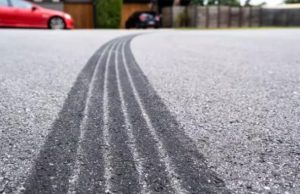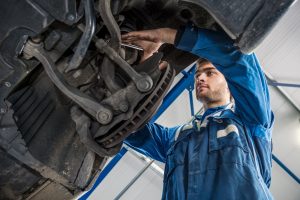When we think about braking performance, most drivers immediately focus on brake pads, discs, or fluid. However, your vehicle’s suspension system plays just as critical a role in determining how effectively you can stop. A worn or damaged suspension doesn’t just make your ride uncomfortable — it can significantly increase braking distance, reduce stability, and compromise safety.
In this article, we’ll explore how the suspension system influences braking efficiency, the signs of suspension wear that affect stopping power, and what steps you can take to restore optimal performance.
The Hidden Connection Between Suspension and Braking

A car’s suspension system works hand-in-hand with the braking system to maintain tire contact with the road. When you apply the brakes, weight shifts forward, compressing the front suspension and unloading the rear.
If the suspension is in good condition, it manages this weight transfer evenly, ensuring all four tires maintain grip. But when components like shocks, struts, or springs are worn, that balance is lost — leading to longer braking distances, skidding, or instability.
How Worn Suspension Increases Braking Distance
Let’s break down the main ways suspension wear affects braking:
| Suspension Component | Function | Effect When Worn | Impact on Braking |
|---|---|---|---|
| Shock absorbers / struts | Control spring movement and tire contact | Reduced damping, excessive bounce | Tires lose contact during braking, increasing distance |
| Springs | Support vehicle weight, maintain height | Sagging or uneven height | Poor weight transfer, instability under braking |
| Bushings & mounts | Absorb vibration and maintain alignment | Cracks or looseness | Misalignment leads to uneven braking force |
| Control arms / ball joints | Maintain suspension geometry | Wear or looseness | Wheels tilt under load, reducing tire grip |
| Wheel bearings | Enable smooth wheel rotation | Play or friction | Increased rolling resistance, unpredictable braking |
When the suspension can no longer control vertical motion effectively, the tires “skip” over the road surface instead of maintaining consistent contact — resulting in reduced friction and longer stops.
The Science of Weight Transfer
During braking, weight shifts from the rear to the front wheels. The suspension’s job is to manage that shift smoothly. If shocks or struts are worn, the front end of the car dives excessively, while the rear lifts — reducing rear tire grip.
This causes:
-
Front tire overload – increased heat and wear.
-
Rear tire underload – reduced braking contribution.
-
Uneven tire wear – degrading traction further.
Result:
The car takes longer to stop, especially on wet or uneven roads.
Symptoms That Indicate Your Suspension Is Affecting Braking
Recognizing early warning signs can save you from dangerous situations. Here’s what to look for:
A. Nose-Diving While Braking
If the front of your vehicle dips sharply when braking, your shocks or struts have likely lost their damping ability. This imbalance reduces braking efficiency and increases stopping distance.
B. Vehicle Pulls to One Side
Uneven suspension wear or damaged bushings can cause one wheel to bear more braking force, making the vehicle veer under braking.
C. Excessive Bouncing After Stops
After braking, the car should stabilize quickly. Continuous bouncing signals worn dampers — meaning the tires lose contact and braking force fluctuates.
D. Uneven Tire Wear
Feathering, cupping, or bald spots on your tires indicate uneven load distribution caused by suspension misalignment.
E. Longer Stopping Distance
If you notice it takes longer to stop despite healthy brake components, your suspension may be the culprit.
Real-World Braking Distance Comparison
The following table illustrates how suspension condition affects braking distance (approximate data for mid-sized sedans from 100 km/h to 0 km/h):
| Suspension Condition | Road Type | Average Braking Distance (m) |
|---|---|---|
| New / healthy suspension | Dry asphalt | 38–42 m |
| Moderately worn suspension | Dry asphalt | 45–50 m |
| Heavily worn suspension | Dry asphalt | 55–60 m |
| Heavily worn suspension | Wet asphalt | 65–75 m |
That’s a difference of over 30 meters between a healthy and worn suspension — more than seven car lengths.
Factors That Worsen Suspension-Related Braking Issues
Several conditions make worn suspension effects even more dangerous:
-
Wet or icy roads – Reduced traction amplifies tire skipping.
-
Uneven road surfaces – Worn shocks can’t stabilize tire contact.
-
Heavy loads – Overloading increases suspension compression.
-
High-speed driving – More pronounced weight transfer and instability.
-
Old tires – Combined with worn suspension, they drastically reduce grip.
How to Check If Your Suspension Is Affecting Braking
You can perform simple checks at home or during maintenance:
DIY Suspension Inspection Steps:
-
Bounce Test: Push down on each corner of the car — it should rise and settle once. More than one bounce = worn shocks.
-
Visual Check: Look for oil leaks on shocks or struts.
-
Tire Check: Inspect for uneven wear or cupping.
-
Ride Height: Compare all corners — sagging indicates spring fatigue.
-
Noise Test: Listen for clunks or squeaks when braking or turning.
If you notice multiple issues, your suspension likely needs attention.
Preventive Maintenance Tips
To maintain optimal braking performance and safety:
-
Inspect shocks and struts every 20,000–30,000 km.
-
Replace suspension components in pairs (left/right) for balance.
-
Avoid overloading — it accelerates suspension wear.
-
Keep tires properly inflated to ensure even pressure distribution.
-
Service wheel alignment after replacing any suspension parts.
Tip: Replacing old shocks or struts can improve braking distance by up to 20%, especially on uneven surfaces.
Replacing Worn Suspension Parts

If diagnostics confirm that worn suspension is affecting braking, replacement is essential for restoring performance.
| Component to Replace | Replacement Interval / When Needed | Expected Improvement |
|---|---|---|
| Shock absorbers / struts | Every 80,000–100,000 km | Improved braking stability, comfort |
| Springs | When sagging or cracked | Restores ride height, weight balance |
| Bushings and mounts | When cracked or noisy | Reduces play and vibration |
| Control arms | If bent or worn | Restores alignment and handling precision |
For quality components designed to restore control and braking efficiency, you can
Buy Suspension online
and find springs, shocks, and mounts compatible with your vehicle.
Conclusion
A worn suspension system is a silent threat to braking performance and road safety. While brakes stop the wheels, it’s the suspension that ensures your tires stay in contact with the road. When it fails, stopping distances increase, stability decreases, and the risk of skidding or losing control rises dramatically.
Regular suspension maintenance, timely replacement of worn components, and balanced load management are essential to keeping your braking system working at its best.
If you’ve noticed nose-diving, uneven tire wear, or a longer stopping distance, it’s time to act — inspect your system and Buy Suspension online to ensure safe, controlled, and confident braking on every journey.
A healthy suspension isn’t just about comfort — it’s about stopping power, safety, and peace of mind.